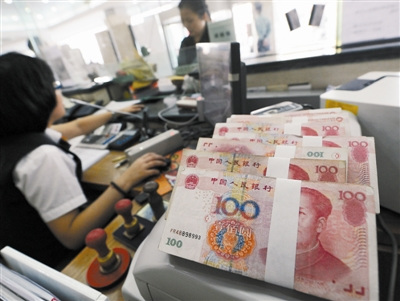(Ecns.cn)! Banks have been actively soliciting for deposit money by luring investors to buy wealth investment products, touting large potential profits, the China Banking Regulatory Commission (CBRC) expressed concern over the matter on June 29.
Client service managers have been required to accomplish deposit tasks ranging from one to two million yuan (US$155 million to $309 million). Some of them were asked to solicit as much as eight million (US$1.24 million) by the end of June.
"We are under huge pressure. Even non-bank tellers, such as administrative workers, are now required to get clients to deposit their money," a staff member said.
According to China Everbright Group chairman Tang Shuangning, liquidity squeeze occurs every year, but it has become particularly severe this year.
"Deposit capital is like a big cake, and every piece of it has been eaten," he said.
The People's Bank of China, the central bank, has raised the required reserve ratio (RRR) 12 times since January 2011 in an effort to curb stubbornly high inflation.
Those hikes, which will directly freeze about 4.2 trillion yuan (US$619 billion), are the cause of the liquidity squeeze, an anonymous insider said.
"Some banks with higher ratios will be out of money if the hikes continue," he said.
Smaller banks can usually ask for callable loans from state-owned banks on the inter-bank market, but state-owned banks are struggling to solve their own liquidity problems, he added.
Large state-owned banks are hit harder by a liquidity squeeze compared to smaller commercial banks because their clients, who are normally large enterprises, tend to apply for larger loans, another inside source said.
Chinese banks had to deposit more than 380 billion yuan (US$58.76 billion) in the central bank to adhere to the new RRR by June 20, when the Chinese authorities were expected to examine the banks' operations.
Several banks that had not met the requirements rushed to borrow money from the money markets. However, larger banks that had already met the new requirements were unwilling to lend.
Under the circumstances, selling wealth investment products is a foolproof method for banks to draw money on their clients' accounts.
By the end of the first quarter, commercial banks had sold 1.9 trillion yuan in wealth investment products, compared with 1.7 trillion yuan at the end of last year, according to the CBRC.
Commercial banks offer revenue of about 7 percent on average for short-term wealth investment products, a rate far higher than demand deposits or the benchmark interest rate of one-year deposits, which stood at 3.25 percent.
According to a statement on its website, the CBRC on Wednesday ordered commercial banks to improve their information disclosure systems and better inform clients about the risks of buying wealth investment products.
Client risk assessment should be based on age, financial statements and investment experience, according to the CBRC.
In the statement, the CBRC divided banks' high-end clients into two groups: private banking clients with financial assets of more than 6 million yuan ($927,000), and high net worth (HNW) clients with a single purchase of wealth investment product no less than 1 million yuan, a standard that matches the country's most experienced trust clients.
The CBRC is now asking for public opinions about the statement.


















